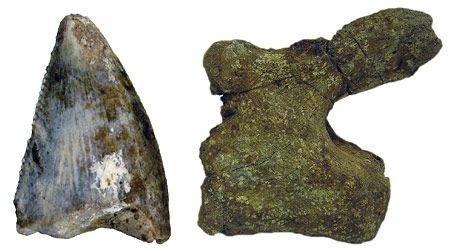First Dinosaur Fossils Discovered In Saudi Arabia: Dry Desert Was A Beach Filled With Bones Of Ancient Animals

An international team of scientists have discovered the first dinosaur fossils in Saudi Arabia, something that is believed to be extremely rare in the Arabian Peninsula.
What is now dry desert was once a beach full of bones and teeth of ancient marine reptiles and dinosaurs, according to scientists from Uppsala University in Sweden, Museum Victoria and Monash University in Melbourne, Australia and the Saudi Geological Survey.
The dinosaur remains -- a string of vertebrae from the tail of a huge “Brontosaurus-like” sauropod, together with some shed teeth from a carnivorous theropod -- were discovered during excavations in the northwestern part of the kingdom of Saudi Arabia along the coast of the Red Sea. The findings were recently published in the scientific journal PLOS ONE.
“Dinosaur fossils are exceptionally rare in the Arabian Peninsula, with only a handful of highly fragmented bones documented this far,” Benjamin Kear, lead study author and a paleobiologist at Uppsala University, said in a statement. “This discovery is important not only because of where the remains were found, but also because of the fact that we can actually identify them. Indeed, these are the first taxonomically recognizable dinosaurs reported from the Arabian Peninsula.”

Dinosaur remains from the Arabian Peninsula and the area east of the Mediterranean Sea are very rare as sedimentary rocks dumped in streams and rivers during the Age of Dinosaurs are rare, scientists said. When these dinosaurs were alive, the Arabian desert was largely underwater, and it formed the northwestern coastal margin of the African continent.
“The hardest fossil to find is the first one. Knowing that they occur in a particular area and the circumstances under which they do, makes finding more fossils significantly less difficult,” Tom Rich, a paleontologist at Museum Victoria in Melbourne, said.
The scientists said that the teeth and bones are about 72 million years old, and they helped scientists describe two types of dinosaur: a bipedal meat-eating abelisaurid distantly related to Tyrannosaurus but only about six meters long and a plant-eating titanosaur perhaps up to 20 meters (65 feet) in length.
The scientists said that similar dinosaur fossils have been discovered in North Africa, Madagascar and South America.
© Copyright IBTimes 2025. All rights reserved.






















